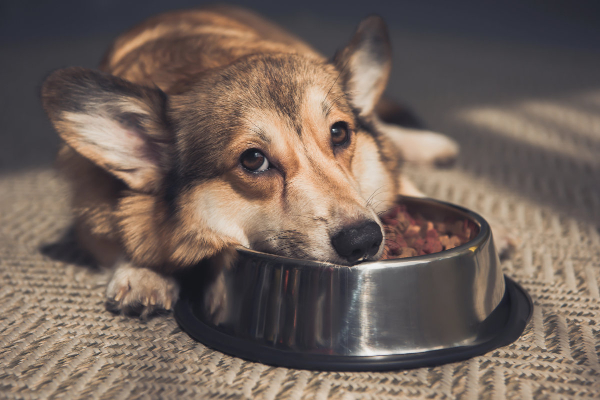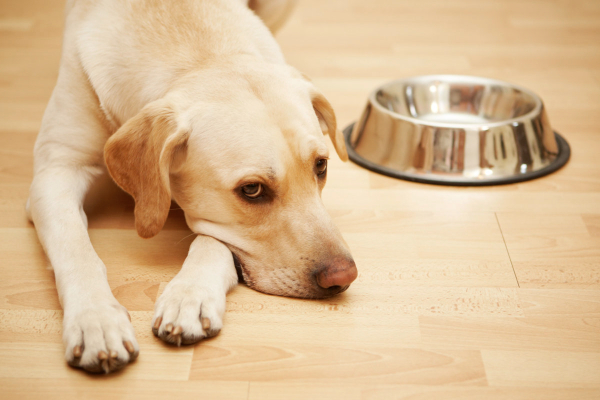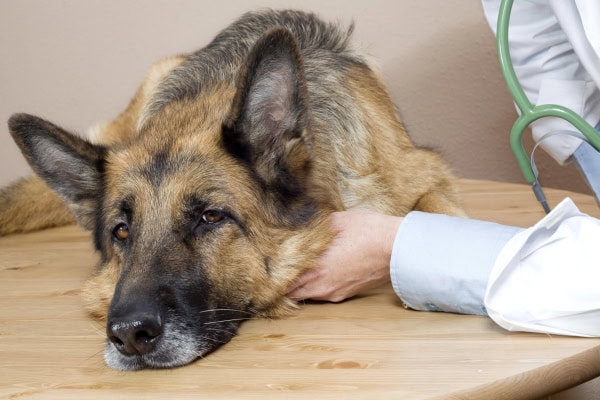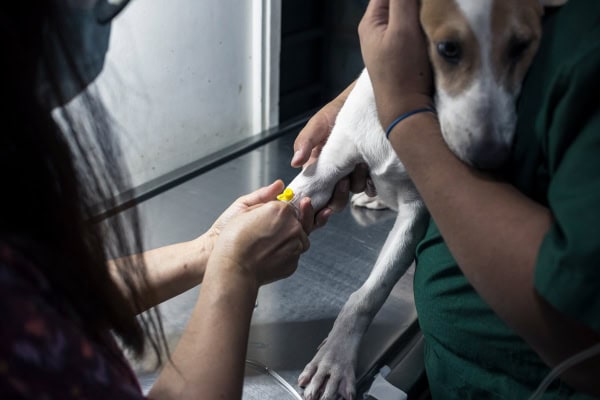Gastritis in dogs, or irritation of the stomach lining, is a fairly common problem. Integrative veterinarian Dr. Julie Buzby explains the signs, types, causes, diagnosis, and treatment of gastritis so that dog parents can recognize gastritis and know what to do if their dog is showing gastritis symptoms.

There is nothing quite like that unmistakable sound of your dog getting ready to vomit to jolt you from the deepest sleep. One second, you’re in dreamland. And the next, you’re scrambling to get your dog off the carpet or bed before it’s too late.
If you’re a dog parent, chances are you’ve been there. While the occasional upset stomach isn’t usually a cause for concern for our canine companions, frequent or sudden bouts of vomiting could be a sign of something more serious like gastritis.
So, what exactly is gastritis in dogs? And how can you help your pup feel better when he or she is feeling particularly puny? Let’s dive in!
What is gastritis in dogs?
Gastritis in dogs is inflammation or irritation of the stomach lining. It usually occurs in dogs when something—like spoiled food, a foreign object, an infection, or even a medication—causes the stomach to become inflamed. This irritation can lead to symptoms like vomiting, reduced appetite, and abdominal pain.
Types of gastritis in dogs
Vets tend to break gastritis into two categories, acute or chronic, based on the duration of clinical signs. Acute gastritis comes on suddenly and usually doesn’t last very long. Chronic gastritis, on the other hand, is a long-term condition where the stomach lining stays inflamed for weeks, months, or even longer.
It is important to differentiate between acute and chronic gastritis in dogs because the two forms require different approaches to diagnosis, treatment, and management.
Acute gastritis is usually triggered by something recent, like eating spoiled food. Once the trigger is removed or treated, the condition typically improves quickly.
Chronic gastritis, however, results from an underlying, long-term issue like a food allergy, chronic disease, or repeated irritation. If your dog is showing signs of chronic gastritis, your veterinarian will want to dig deeper. He or she may potentially recommend running more tests to find the root cause, which may not always be immediately obvious.
What are the symptoms of gastritis in dogs?
As you might imagine, many of the symptoms of gastritis in dogs are related to the stomach. However, they can vary depending on the dog and situation. Some of the more common signs include:
Vomiting
Vomiting is the hallmark sign of gastritis. Dogs may vomit multiple times, and the vomit could contain undigested food or yellow bile. If your dog’s gastritis resulted from eating something problematic, the food or foreign material in question may also appear in the vomit.
Bloody vomit or diarrhea
In more severe cases you might even notice blood in the vomit. This can be bright red blood. Or if the blood has had time to be digested, the vomit can have black specks and a characteristic “coffee grounds” appearance. Both situations fall into the category of hemorrhagic gastritis.
If the intestines are inflamed too, the dog may have diarrhea, which can be bloody in some cases.
Nausea
Many dogs with gastritis also feel quite nauseous. You may notice your dog licking his or her lips, hypersalivating or drooling, swallowing excessively, or even grinding his or her teeth. All of these are signs of nausea.

Reduced appetite (anorexia)
Dogs with gastritis often lose interest in food due to stomach discomfort. They may eat less or refuse food entirely.
Lethargy
During a bout of gastritis your dog might be a lethargic dog. He or she may be unusually tired, weak, or less interested in activities he or she normally enjoys.
Abdominal pain
Whining, seeming restless or unable to get comfortable, or adopting a hunched posture or a “prayer pose” are all more subtle ways that your dog show signs of abdominal discomfort.
Dehydration
Excessive vomiting, especially if combined with a lack of interest in food and water, can eventually lead to dehydration. A dehydrated dog may have dry gums, a dry nose in dogs, or reduced energy.
When should you call the vet?
If you are seeing some of the signs of gastritis, carefully evaluate your dog and the situation to determine if a vet visit is in order.
Occasional vomiting isn’t unusual for dogs and may not immediately be cause for concern. You can sometimes treat mild forms of acute gastritis at home—which we will cover in the next section. However, if your dog continues to vomit frequently, it could indicate a more serious issue that requires veterinary attention.
As a rule, vomiting that lasts for more than 24 hours warrants a call to your veterinarian. You should have your furry family member evaluated sooner if you notice blood in the vomit, if you are worried about dehydration, or if your precious pup seems unusually tired, has trouble standing, or is less responsive than normal.
Similarly, if the vomiting is accompanied by unwillingness to eat for more than 24 hours or if your dog has frequent bouts of vomiting over weeks or months, it could be a sign of chronic gastritis or another ongoing issue. These scenarios also warrant additional diagnostic testing and treatment.
It’s always better to err on the side of caution, especially if your dog seems uncomfortable or is showing multiple symptoms. The sooner you get your canine companion evaluated, the sooner your veterinarian can get to work diagnosing the underlying issue. And the sooner he or she can start working with you to formulate the right treatment plan to help your furry family member feel better.
How can you treat gastritis in dogs at home?
As mentioned earlier, sometimes you may be able to treat acute gastritis at home. This is especially likely to be the case if the symptoms are mild and there is no serious underlying issue at play. Follow these steps to try to get your precious pup feeling better at home:
1. No food for 12 to 24 hours
Start by withholding food for 12 to 24 hours to allow your dog’s stomach to settle. This can help reduce irritation and give the digestive system a chance to recover.

2. Allow access to water
Don’t withhold water. Hydration is crucial, especially since vomiting can lead to dehydration. Please ensure your dog has access to fresh water.
If he or she is drinking too much and vomiting, you may want to offer small amounts of water at a time instead of allowing your dog to drink at will.
3. Feed a bland diet when it is time to start feeding your dog again
Once the fasting period is over, if there has been no further vomiting, you can start introducing a bland diet for dogs. Boiled or baked skinless, boneless chicken breast mixed with plain white rice is a great option. You can also substitute cooked low fat ground turkey for the chicken. Plus, plain canned pumpkin for dogs (not pumpkin pie filling) can help soothe the stomach and add fiber for dogs.
4. Keep portions small at first
Start with small amounts of food at a time to see how your dog’s stomach reacts. If he or she tolerates the bland diet well, you can gradually increase the amount over the next 12 to 24 hours.
5. Monitor your dog carefully
Keep an eye on your dog’s condition. Look for signs of improvement, such as resolution of vomiting, increased appetite, and improved energy levels. Keep in mind, if symptoms worsen or do not improve within 24-48 hours, it’s time to consult your veterinarian.
6. Return to a normal diet over a few days
Once your dog shows signs of recovery (e.g., no vomiting, normal energy, and a good appetite), you can gradually reintroduce his or her regular diet over a few days. Mix the regular food with the bland diet, increasing the regular food portion gradually over two to three days.
When in doubt, call the vet
Remember, the instructions above are for dogs who just started to vomit and have mild symptoms. If your dog continues to vomit for more than 24 hours, shows signs of dehydration, has blood in the vomit or stool, or appears lethargic or painful, you should contact your veterinarian immediately.
Many cases of acute gastritis resolve with home care. But it’s important to be cautious and attentive to your dog’s needs and seek medical intervention if you are at all concerned about his or her response to your treatment at home.
How is gastritis diagnosed?
If you find yourself needing to seek veterinary care for your dog’s gastritis symptoms, it can be helpful to know what to expect. Rest assured that your veterinarian will work closely with you to tailor his or her diagnostic plan to confirm the diagnosis of gastritis and identify any underlying causes. This will enable your vet to develop an appropriate treatment plan geared toward getting your furry family member feeling better as soon as possible.
Taking a history
First, your veterinarian or other member of the veterinary team will take a thorough history. You will likely be asked about:
- Your pup’s diet, including any recent changes
- Any exposure to toxins or potential consumption of foreign objects
- Pertinent previous health issues
- The duration and nature of the symptoms (e.g. vomiting frequency and consistency)
This information will be crucial for helping your veterinarian make diagnostic and treatment recommendations.

Performing a physical exam
After obtaining a history, your veterinarian will perform a comprehensive physical exam. This will include palpating your dog’s abdomen for signs of pain or masses, listening to your dog’s heart and lungs, and assessing your dog’s hydration status, mucous membrane color, and overall physical condition.
Running blood tests
Basic blood tests for dogs can help your veterinarian get a better idea of how serious your pup’s illness is and whether a more significant underlying systemic disease might be at play.
Your veterinarian may include blood work such as a complete blood count (CBC) in the diagnostic plan. This test can help detect signs of infection, inflammation, or dehydration. Often the vet will also run a biochemistry panel to assess organ function and check for electrolyte imbalances.
Obtaining diagnostic imaging
The vet may take abdominal radiographs, or X-rays, to help identify any obstructions, foreign bodies, or abnormalities in the gastrointestinal tract that might warrant further work-up or treatment.
An abdominal ultrasound may also be part of the diagnostic plan because it can provide an even more detailed view of the stomach and intestines. Plus, it can help identify fluid accumulation, thickening of the stomach lining, visual changes in the stomach wall that might indicate stomach ulcers in dogs, or other structural issues.
In some cases, your veterinarian may recommend a more specialized test known as endoscopy. Endoscopy involves inserting a small camera into the gastrointestinal tract while your pup is under general anesthesia. This allows for direct visualization of the stomach lining and may also enable your veterinarian to take biopsies to definitively diagnose and characterize the inflammation in the stomach.
Matching the diagnostics to the situation
Your veterinarian may or may not recommend all these diagnostics. His or her plan will depend in large part on the severity of your furry family member’s signs. However, duration of signs also plays a role. Ongoing vomiting or other symptoms suggestive of chronic gastritis also warrant a more aggressive work-up.
What are the causes of gastritis?
As you may remember, gastritis in dogs can be classified into acute and chronic forms, each with different causes. One thing to note is that especially for acute gastritis, an obvious cause is not always found. But regardless of that, it is nice to know what to think about when trying to determine what might have set off your canine companion’s tummy troubles.
Causes of acute gastritis in dogs
Some potential causes of acute gastritis in dogs include:
Dietary indiscretion
Eating spoiled or rotten food can irritate the stomach lining. Continuing the theme of dogs eating things they shouldn’t, eating things like toys, bones, or garbage can all irritate the lining of the stomach and cause signs of gastritis as well.
In fact, one of the other names for acute gastritis is “garbage gut.” This name points to the fact that dogs getting into the trash and then developing stomach upset is a common cause of acute gastritis. Even if the food isn’t spoiled, a change in diet or a sudden exposure to rich or fatty foods can still upset a dog’s stomach.

Infections
Certain bacteria (like Salmonella or E. coli) or viruses can cause acute gastritis.
Parasites
Parasites like giardia or roundworms can lead to gastrointestinal irritation. But they will also often be accompanied by diarrhea.
Toxins
Ingesting toxic substances, such as certain poisonous plants or household cleaners, can irritate the stomach.
Medications
Some medications, especially non-steroidal anti-inflammatory drugs (NSAIDs) like carprofen for dogs can irritate the stomach lining and lead to gastritis. This may be the case even when they are given as prescribed.
Stress
Sudden changes in routine, new environments, or other stressors can sometimes trigger acute gastritis in sensitive dogs. (And they can also cause stress colitis in dogs.)
Causes of chronic gastritis in dogs
On the other hand, some of the more common causes of chronic gastritis in dogs include:
Food allergies or intolerances
Chronic reactions to certain ingredients in food can cause ongoing inflammation of the stomach lining.
Infections
Long-term infections, such Helicobacter pylori infections in dogs, can lead to chronic gastritis.
Autoimmune diseases
Inflammatory bowel disease (IBD in dogs) is an autoimmune condition in which the body’s immune system creates inappropriate inflammation within the gastrointestinal tract. Sometimes this inflammation can be present throughout the GI tract. Or it can be limited to certain portions of the intestines. If it is present in the stomach this can lead to chronic gastritis.
Underlying systemic disease
Other health conditions such as pancreatitis in dogs, liver disease in dogs, or kidney failure in dogs can lead to chronic gastritis due to altered digestion or metabolic changes. Pancreatitis can cause local inflammation which can spread to the stomach. And kidney disease leads to a particular type of gastritis called “uremic gastritis.” It occurs when toxins that the kidneys would normally filter out build up in the bloodstream.
Cancer
Cancer within the stomach, most commonly either lymphoma in dogs or gastric carcinoma, can lead to chronic irritation and inflammation of the stomach lining.
The type of gastritis matters
Understanding the different causes of acute and chronic gastritis in dogs is essential for effective diagnosis and treatment. While acute gastritis is often linked to immediate dietary indiscretion or environmental factors, chronic gastritis typically stems from underlying health issues.
Therefore, if anything you have read thus far leads you to suspect your dog has more severe or chronic gastritis, consult your veterinarian for a thorough evaluation and appropriate treatment.
What is the treatment for gastritis in dogs?
When at-home treatment isn’t enough or your dog has chronic gastritis, the veterinarian will discuss other treatment options with you.
In short, the treatment for acute gastritis focuses on immediate symptom relief. But chronic gastritis treatment entails more long-term management, dietary adjustments, and a focus on addressing specific underlying causes. Both approaches require veterinary guidance, but being a chronic condition, chronic gastritis typically involves more comprehensive monitoring and care to ensure your pup’s overall well-being is maximized.
Now let’s take a closer look at the various treatments for gastritis in dogs.
Fluid therapy
If your beloved canine companion appears dehydrated, or even if he or she isn’t yet dehydrated but is having ongoing vomiting, your veterinarian will likely want to provide fluid therapy.

Sometimes that will be subcutaneous fluids for dogs (i.e. fluids given under the skin) if your pup’s condition is stable enough to consider outpatient treatment. But if your dog needs to remain in the hospital for more aggressive care, then the vet will likely start him or her on IV (intravenous) fluids.
Medications
When treating gastritis in dogs, veterinarians may prescribe several types of medications depending on the severity of the condition and the suspected or diagnosed underlying cause.
Anti-nausea medications
- Maropitant (Cerenia® for dogs)—Veterinarians commonly use Cerenia to prevent and treat vomiting and nausea in dogs. It works by blocking specific receptors in the brain that trigger vomiting. Cerenia is especially effective for acute gastritis and it can be administered as an injection or a pill. Dogs take Cerenia one time per day.
- Ondansetron (Zofran®)—Zofran is another anti-nausea medication that can help control vomiting. Veterinarians may give it instead of, or in addition to, Cerenia. Zofran is also available as an injectable or a pill. It is given more frequently than Cerenia and can be administered up to three times per day.
Antacids
- Famotidine (Pepcid®)—Famotidine is a histamine-2 blocker that reduces the production of stomach acid, helping to relieve irritation of the stomach lining.
- Ranitidine (Zantac®)—Similar to famotidine, ranitidine decreases stomach acid production and can be helpful in managing gastritis symptoms.
- Omeprazole or Pantoprazole—These medications are a specific type of antacid known as proton pump inhibitors (PPIs). Omeprazole for dogs is a capsule or pill while pantoprazole is an injectable medication. PPIs reduce acid secretion in the stomach through a different mechanism than the previously described antacids. And they tend to be more effective for longer-term management of gastric acidity.
Sucralfate (Carafate®)
Sucralfate works by forming a protective barrier over the stomach lining, which can help heal ulcers or inflammation in the stomach. Vets often prescribe it in conjunction with other medications for gastritis. However, you should not administer it at the same time as other medications since it will decrease their absorption.
Other miscellaneous medications for gastritis
- Antibiotics—Occasionally, antibiotics may be warranted if your veterinarian suspects an infectious cause of gastritis. The specific antibiotic will depend on the suspected pathogen.
- Immunosuppressive medications—If your veterinarian either confirms or strongly suspects a more chronic immune-mediated cause of gastritis, then he or she may recommend immunosuppressive medications like prednisone for dogs or cyclosporine (Atopica®).
- Probiotics—Although not medications in the traditional sense, probiotics can be beneficial in promoting healthy gut flora and aiding in recovery from gastrointestinal issues. They can help restore the balance of beneficial bacteria in the GI tract and may be a good adjunctive therapy in some dogs with gastritis.
Diet change
Dogs with chronic gastritis may need a long-term adjustment to their diet. Your veterinarian may recommend either a hypoallergenic or limited-ingredient diet. It often takes some trial and error to find the right diet that will help your precious pup feel better. Being patient and maintaining an open line of communication with your veterinarian can help make this process go more smoothly for everyone involved.
Additional management considerations for chronic gastritis
Chronic gastritis often requires extensive testing to identify the specific underlying cause so that treatment can be targeted appropriately. This treatment may involve additional medications or therapies, some of which may not be listed here.
If your beloved canine companion is suffering from chronic gastritis, this will likely necessitate regular veterinary check-ups. During those visits, the vet can assess your dog’s progress and monitor him or her for complications such as the development of gastric ulcers.
A gastritis diagnosis doesn’t have to feel like a kick in the gut
The great news is that the prognosis for gastritis in dogs is often quite favorable, especially for acute cases that receive prompt treatment. Chronic gastritis requires more careful management and monitoring. But it is still possible to manage it effectively with the right approach.
If you notice symptoms of gastritis in your precious pup, and if those signs don’t resolve quickly, it is important to seek veterinary care to ensure the best possible outcome. Remember, with the right care, many dogs bounce back quickly and return to their happy, playful selves!
Has your dog ever been diagnosed with gastritis?
Please comment below.


My Pekingese just had an ultrasound since her only symptom is ongoing off and on inappetance where she will eat a diet then refuse it. This has gotten worse and worse over last few months. An ultrasound her regular vet did showed an inflamed stomach and thickened outer lining. She has had No vomiting normal stool only symptom has been walking away from her food and last week not begging for ours. Her vet gave us Hills Biome and Cerenia. I gave Cerenia and forty minutes later she vomited gagged threw up twice when she has not vomited for a very long time. U handfed Biome which she ate yesterday but refused today. Finally made chicken and rice and she ate first small serving but finished only half of second. Seeing vet again tomorrow.
Hi Elizabeth,
I am sorry your Pekingese is having these ongoing GI issues. I can only imagine how frustrating it must be to still have more questions than answers despite all the testing that has been done. Did you find out any new information from the recent visit with your vet? It may be time to consider a consultation with an internal medicine specialist. Hoping for answer and a clear path forward. Wishing you both all the best as you navigate this unknown path.